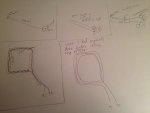J.P.
Senior Member
- Location
- United States
I haven't messed with gate openers, garage doors much beyond supplying power. I was leaving a job recently and the fence/gate installer was out by the gate. I stopped and asked if he need the breaker turned on.
It turned out that he needed his keypad wired and programmed and the batteries hooked up and a gate loop put in. I had to set the gate limits and the remotes as well.
I had no clue and still don't have much of a clue about the gate loop. I thought it was a pre-made part that just got wired in to the operator.
In this case it was some #12 THHN....
I read a few differing opinions on installation. The boss's opinion is what counts though, he seemed pretty vague on details. But I still am curious.
Does the wire have to be twisted?
I have seen a few diagrams where they take a single strand from the operator make 3 turns around there trench or cut and head back to the operator. The only twisting was where the lead in wires were just to keep them neat.
The method I used was to make 100ft of twisted wire at 6 twist per foot and loop that around the trench once.
Could I have put it in pvc? Would it even work through pvc?
Would 12/2 urd work for this or is the separation of the wire inside the insulation to great?
I didn't get to test the loop because the loop detector module wasn't even ordered. I would really have liked to try out both methods before covering up the wire.
It turned out that he needed his keypad wired and programmed and the batteries hooked up and a gate loop put in. I had to set the gate limits and the remotes as well.
I had no clue and still don't have much of a clue about the gate loop. I thought it was a pre-made part that just got wired in to the operator.
In this case it was some #12 THHN....
I read a few differing opinions on installation. The boss's opinion is what counts though, he seemed pretty vague on details. But I still am curious.
Does the wire have to be twisted?
I have seen a few diagrams where they take a single strand from the operator make 3 turns around there trench or cut and head back to the operator. The only twisting was where the lead in wires were just to keep them neat.
The method I used was to make 100ft of twisted wire at 6 twist per foot and loop that around the trench once.
Could I have put it in pvc? Would it even work through pvc?
Would 12/2 urd work for this or is the separation of the wire inside the insulation to great?
I didn't get to test the loop because the loop detector module wasn't even ordered. I would really have liked to try out both methods before covering up the wire.


